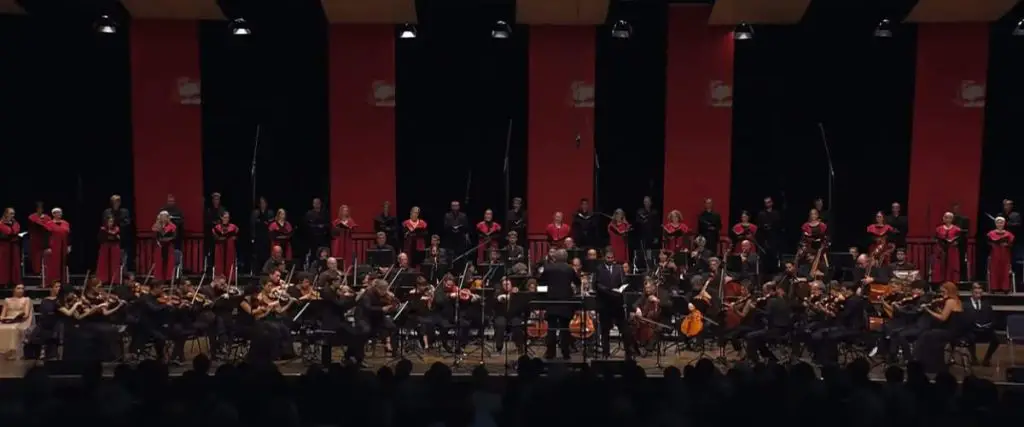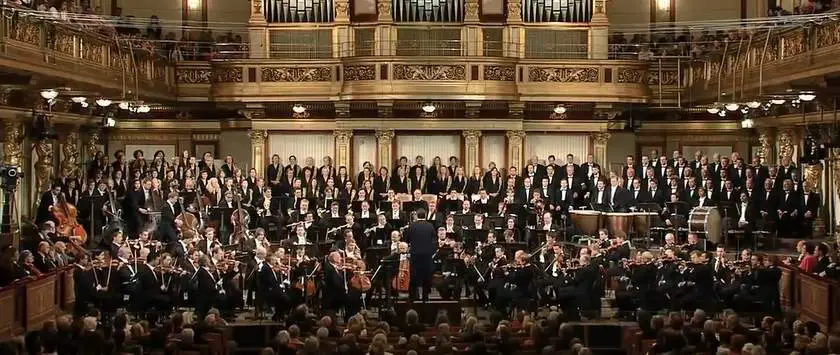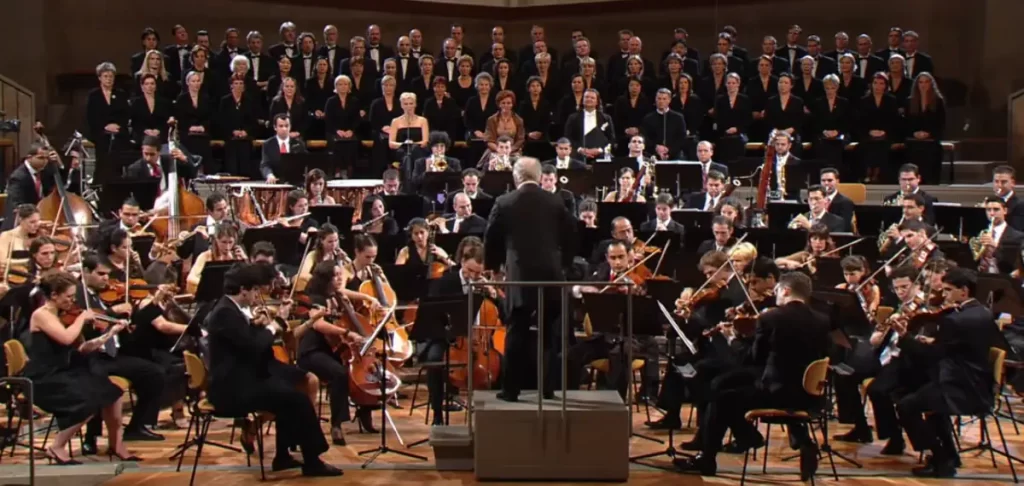Conducted by Riccardo Muti, the Chicago Symphony Orchestra and Chorus perform Ludwig van Beethoven’s Symphony No. 9 in D minor, Op 125. This performance was recorded on May 7, 2015.
On May 7, 1824, Beethoven shared his 9th Symphony, the “Choral” with the world even though he could never hear it. On May 7, 2015, celebrate the anniversary of Beethoven’s most glorious and jubilant masterpiece with the Chicago Symphony Orchestra and Chorus, conducted by Riccardo Muti, a prolific recording artist who has received dozens of honors. An exhilarating testament to the human spirit, Beethoven’s Ninth bursts with brooding power and kinetic energy and culminates in the exultant hymn, “Ode to Joy.”
- Chicago Symphony Orchestra & Chorus
- Riccardo Muti: conductor
- Camilla Nylund: soprano
- Ekaterina Gubanova: mezzo-soprano
- Matthew Polenzani: tenor
- Eric Owens: bass-baritone
- Duain Wolfe: chorus director
Beethoven’s Symphony No. 9
Beethoven’s Symphony No. 9, often referred to as the “Choral” Symphony, stands as one of the most celebrated and influential pieces in Western music history. Composed between 1822 and 1824, it was Ludwig van Beethoven’s final completed symphony and represents a stunning display of musical innovation and emotional depth.
The Ninth Symphony is remarkable for its scale, complexity, and the introduction of vocal soloists and a choir in the final movement. This was a groundbreaking move, as symphonies had traditionally been purely instrumental. The text for the choral finale was taken from Friedrich Schiller’s “Ode to Joy,” a poem that speaks to themes of universal brotherhood and the joy of human solidarity. Beethoven’s setting of this text has become one of the most famous pieces of music in history, often performed at significant events and widely recognized even by those unfamiliar with classical music.
Beethoven’s deafness, which had progressed significantly by the time he composed this symphony, adds a layer of poignancy to this work. His inability to hear his own monumental composition underscores the triumph of creative spirit over physical limitations.
The Ninth Symphony broke new ground in terms of structure and length. It was one of the longest symphonies of its time, stretching the boundaries of what was considered acceptable in a concert setting. It also challenged contemporary audiences with its complexity and emotional depth, spanning a broad range of feelings from despair to exultation.
The influence of the Ninth Symphony on later composers cannot be overstated. It opened new horizons in symphonic writing and is often seen as marking the beginning of the Romantic era in music. Its emphasis on a personal, emotional narrative set a precedent that many later composers would follow.
The premiere of the Ninth Symphony, conducted by Beethoven himself in Vienna in 1824, was a significant event. Although Beethoven was by this time almost completely deaf, he insisted on conducting. The orchestra was instructed to ignore his tempo and follow the assistant conductor, Michael Umlauf. The performance was a resounding success, with reports of the audience erupting into applause and Beethoven, unable to hear the reaction, having to be turned around to see the ovation.
Today, the Ninth Symphony remains a fixture in the repertoire of orchestras around the world and continues to be a source of inspiration and wonder for both musicians and listeners. It’s a testament to Beethoven’s genius and his enduring legacy in the world of classical music.

Ludwig van Beethoven’s Symphony No. 9 is in four movements. With the starting times in the video:
- 01:39 Allegro ma non troppo, un poco maestoso (D minor)
- 19:42 Scherzo: Molto vivace – Presto (D minor)
- 35:39 Adagio molto e cantabile – Andante moderato – Tempo primo – Andante moderato – Adagio – Lo stesso tempo (B-flat major)
- 52:13 Recitative: (D minor-D major) (Presto – Allegro ma non troppo – Vivace – Adagio cantabile – Allegro assai – Presto: O Freunde) – Allegro molto assai: Freude, schöner Götterfunken – Alla marcia – Allegro assai vivace: Froh, wie seine Sonnen – Andante maestoso: Seid umschlungen, Millionen! – Adagio ma non troppo, ma divoto: Ihr, stürzt nieder – Allegro energico, sempre ben marcato: (Freude, schöner Götterfunken – Seid umschlungen, Millionen!) – Allegro ma non tanto: Freude, Tochter aus Elysium! – Prestissimo, Maestoso, Molto prestissimo: Seid umschlungen, Millionen!
Beethoven changes the usual pattern of Classical symphonies by placing the scherzo movement before the slow movement (in symphonies, slow movements are usually placed before the scherzo). This was the first time that he did this in a symphony, although he had done so in some previous works (including the quartets Op. 18 no. 5, the “Archduke” piano trio Op. 97, and the Hammerklavier piano sonata Op. 106).
Interestingly, the best-loved movement of Beethoven’s Symphony No. 9 today, the fourth, “choral”, initially received negative criticism: it is considered “cryptic and eccentric, the product of a deaf and aging composer.” The great Italian composer of operas, Giuseppe Verdi complained about vocal writing. In a letter he wrote to Clarina Maffei dated 20 April 1878, he said the symphony was:
“…marvelous in its first three movements, very badly set in the last. No one will ever surpass the sublimity of the first movement, but it will be an easy task to write as badly for voices as is done in the last movement.”
Dutch keyboard player, conductor, musicologist, teacher, and editor Gustav Leonhardt objected to the text itself, saying: “That ‘Ode to Joy’, talk about vulgarity! And the text! Completely puerile!”
But today, music critics almost universally consider the Ninth Symphony one of Beethoven’s greatest works, and among the greatest musical works ever written.
Sources
- Symphony No. 9 (Beethoven) on Wikipedia


![Beethoven: Symphony No. 9 [Bernstein]](https://andantemoderato.com/wp-content/uploads/2015/06/Leonard-Bernstein-Beethoven-Symphony-No-9-Berlin-1989.jpg)